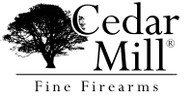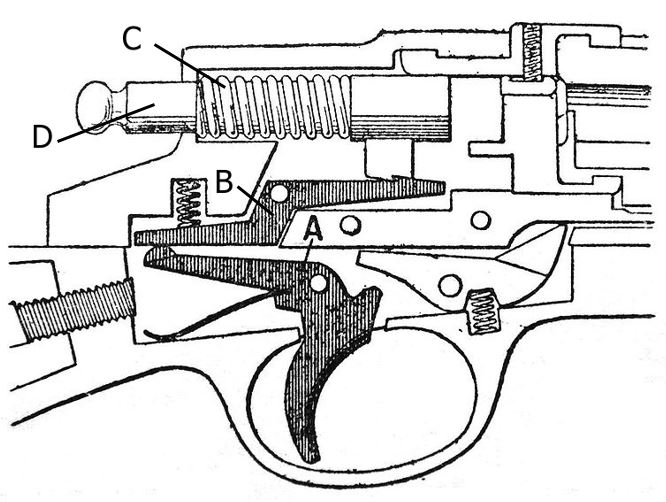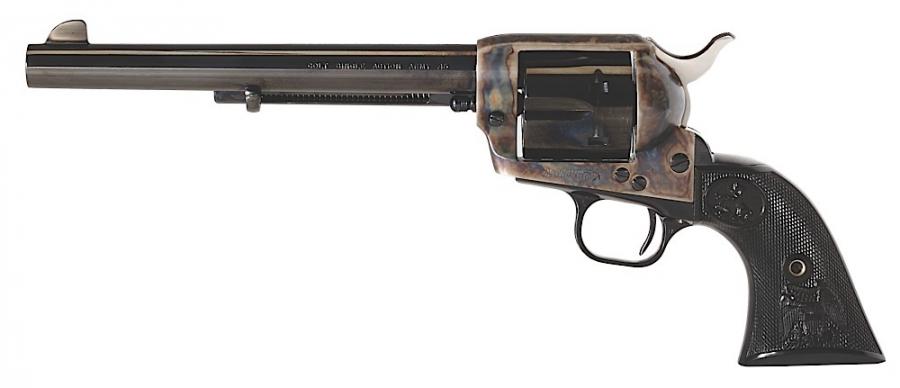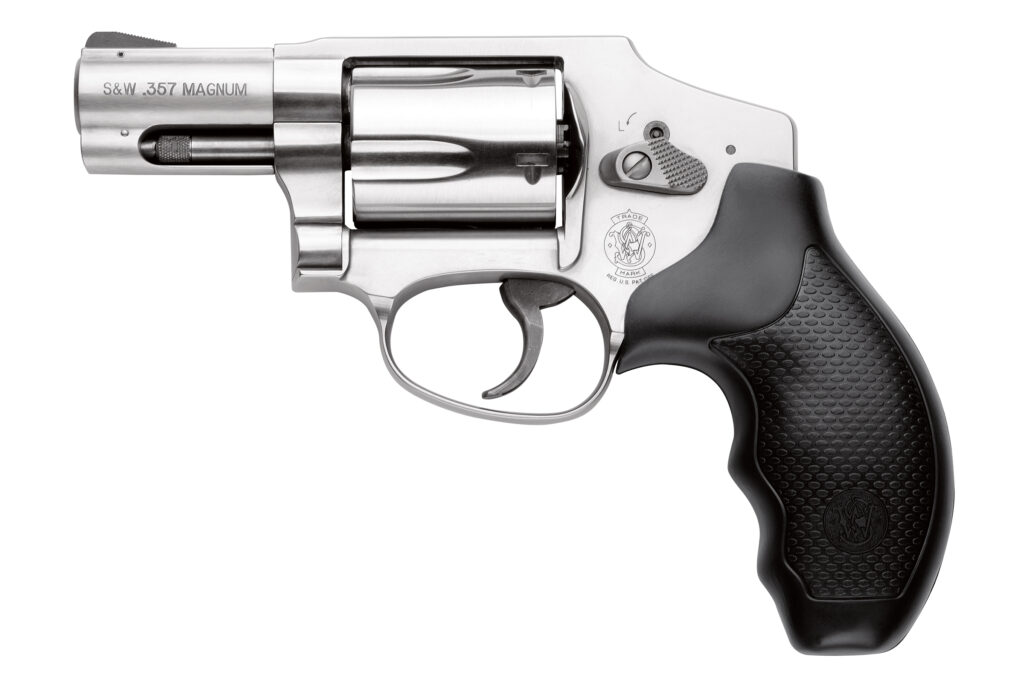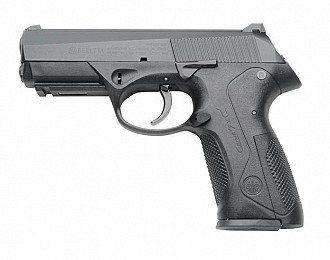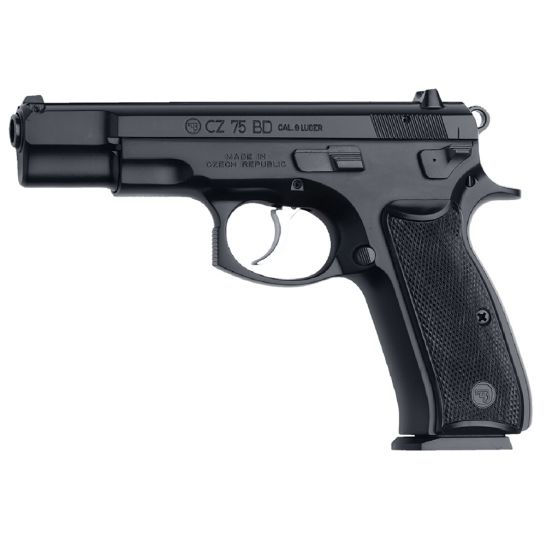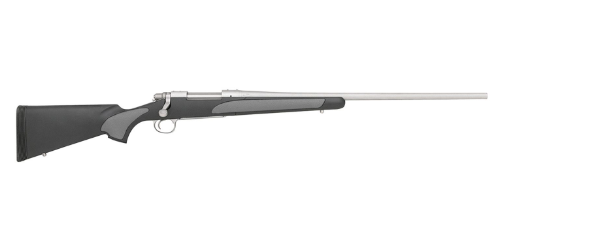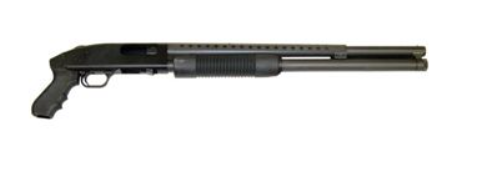Exploring the Mechanics of Firearm Trigger Types: A Comprehensive Guide
Posted by Mandu Moses on Mar 29th 2024
When it comes to gun functionality, most people argue that a proper grip is what matters. But to top-tier shooters, a trigger is what controls all the shooting and safety aspects of a firearm. That means anyone planning to handle a gun should first learn about different types of firearm triggers and how they work. This allows you to manipulate the trigger skillfully and safely to hit your target.
(A) trigger, (B) sear, (C) striker spring, (D) striker.
Image By: Larousse
Trigger types and actions are often used interchangeably, especially when referring to firearm loading, unloading, and firing. However, when viewed from the point of internal working mechanisms or linkages, triggers operate differently. How it works depends on the hammers they are connected to and the firearm’s design. These unique differences in configurations are what determine the steps required when handling any gun.
Operating a trigger is a relatively simple act. You point to the target, remove the safety, and pull the trigger to fire. These steps may, however, be complicated if you don't know the hacks of working a trigger.
This article gives you a detailed look at different trigger types and actions, and how to handle any firearm with expertise.
What is Trigger Discipline?
Understanding the fundamental gun safety and control, in this case, trigger discipline is essential in keeping those around you safe. It allows you to shoot accurately when in danger.
A Video: Navy SEAL Discusses Trigger Discipline on concealed carry firearms - Tactical Tip
Trigger discipline involves keeping your index (trigger) finger outside the trigger guard of the gun until it is the right time to shoot. Although modern guns are designed to fire only when the trigger is pulled, accidental shooting or negligent ammunition discharge can occur and can cause harm to oneself or others. Therefore, as one of the four cardinal rules of firearm safety, it is advisable to always keep the index finger outside the trigger guard until ready to fire.
While proper trigger discipline may sound like a simple rule, many people overlook it, especially if they have not handled a firearm for a long time. To make it a habit, most shooting instructors will advise you to practice trigger discipline repetitively to build confidence with firearms.
Trigger discipline also involves two golden rules:
- When to place your finger outside the trigger guard and when to place it on the trigger. When not about to shoot, you should always put your finger alongside the gun frame above the trigger and parallel to the barrel. You can maintain physical contact with the frame using the pad of the index finger or extend it completely alongside the frame without any contact.
- When in a classic imminent threat position (a point of no return) and you are ready to shoot, you can now place your finger on the trigger and pull it.
Most instructors recommend placing the finger only when the firearm's muzzle is pointing toward the target and your sight is at the edge of the extended target zone. If you place it too soon, you risk firing too early and miss the target. Whereas, if you place it too late, you are likely to take too much time to shoot.
Cardinal Rules of Firearm Safety
- Treat every firearm as if it is loaded.
- Never point a firearm at anything you are not willing to destroy.
- Keep your finger off the trigger until you are ready to fire.
- Be sure of your target and what is beyond it.
Types of Triggers and Actions
Trigger actions refer to how firearms operate to release ammunition when triggers are pulled. When a trigger is pulled or pressed, it releases the striker or hammer that hits the primer on the cartridge and fires a shot. Depending on the trigger action type, pressing the trigger also initiates other internal operations that prepare the firearm to release the ammunition.
Firearms are also categorized into striker-fired and hammer-fired firing mechanisms. Striker-fired firearms use striker rods or firing pins driven by springs to hit the bullet primers. They are straightforward to operate and feature safety mechanisms incorporated into the trigger and all firing functionality kept inside the firearm.
Hammer-fired guns, on the other hand, have hinged levers that strike the firing pins. The pins then hit the bullet primer to fire a shot. This firing mechanism is common in 1911 designs, revolvers, and most competition pistols.
Here are the main types of trigger actions:
Single-Action Only (SAO)
Single-action is the earliest and simplest trigger action type found mostly in the first repeating firearms. As the name suggests, this type of trigger action is designed to do one primary job: releasing the spring tension in the hammer to hit the firing pin. That means for the gun to fire, the hammer must be cocked, drawing it back and holding it under pressure. Pulling the trigger when the hammer is not cocked will not fire the ammunition.
You can cock the hammer in two ways:
- It can be done manually by pulling it back with a thumb (as on a revolver) or mechanically using the bolt.
- It can be done by sliding it back into the cocking position when the auto-loading firearm is charged or subsequently cycled.
The good thing about single-action triggers is that they are shorter and lighter, and they also have the lowest resistance. It is also easier to use single-action firearms since they require little pressure and motion to hit the target.
Examples of Single-Action Only firearms
Single-action triggers are mostly found in revolvers and handguns, though you can also find them in long arms. Examples of guns with single-action triggers include Colt M1873 Single-Action Army, Ruger Mark IV, Colt M1911, Browning Hi-Power, and the FN Five-seveN.
Double-Action Only (DAO)
Double-action triggers have two jobs: cocking and releasing the hammer when pulled. That means when the trigger is pulled or pressed, it cocks the hammer and releases it, allowing it to fall forward and strike the firing pin. The hammer then remains at rest and is cocked again when depressing the trigger.
The DAO firearms do not have the decocking feature. Instead, their hammers have a double-striking feature that re-engages the sear to re-cock and release the hammer on each firing. This allows you to fire non-stop without having to eject the chambered cartridge by racking the slide.
The double-action trigger mechanism is mostly found in service revolvers and semi-automatic handguns popularly used by police officers during the 20th century.
For the case of revolvers, pulling the trigger will see the cylinder rotate to move the cartridge into position. When the cylinder stops moving, the hammer is released and hits the firing pin, leading to a shot.
Drawbacks
The downside of DAO triggers is that they need a heavier trigger pull with no access to the hammer. However, this may also be a safety precaution against negligent discharge (ND) or accidental firing due to the longer and heavier trigger pull required to release the ammunition. That means one needs to decide to use DAO firearms only during extremely dangerous situations since they only have one consistent trigger pull.
Examples of Double-Action Only firearms
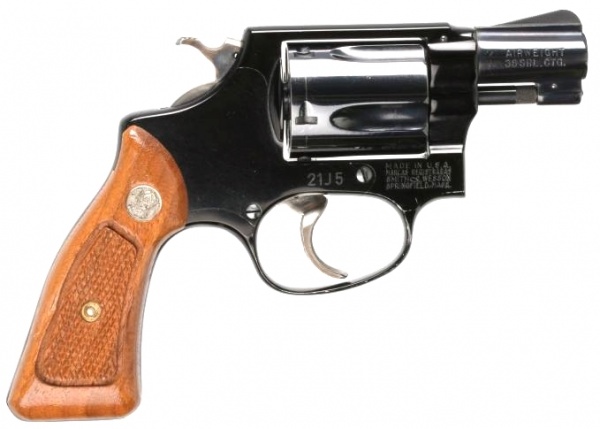
Image courtesy: imfdb
Double-action triggers are common in handguns or short guns used for self-defense. These guns are ideal for close-range shooting or backup weapons. They include the Smith & Wesson 640 revolver pistol, Beretta Px4 Model D Pistol, SIG Sauer Double-Action, and Smith & Wesson M37 revolver.
Here's a video illustrating the difference between a single and double action.
Double-Action/Single-Action (DA/SA)
Double-action/Single-Action (DA/SA) triggers combine the working mechanisms of double-action followed by single-action. That means the triggers use a long and heavy trigger pull for the initial shot, followed by a shorter and lighter trigger pull for each cycle.
Simply put, the first press on a DA/SA trigger will cock the hammer and release it to fire a shot. The pistol will then recoil from the first shot and cycle to eject and chamber the cartridge while cocking the hammer. To fire subsequent shots, the pistol will switch to SA mode because the cycling with each recoil will be used to prep the pistol.
DA/SA triggers work by locking the hammer in the cocked position as the slide recoils backward, preparing the hammer to fall when the slide feeds another round in the battery. Although this is a default setting for most DA/SA firearms, you can switch to SA mode by cocking the hammer manually using your thumbs or pistol’s slides.
DA/SA guns also feature decockers, usually integrated into the safety levers which shooters can push downwards beyond the safe position to decock the hammer.
Drawbacks
The only downside with DA/SA trigger firearms is that you will need to be familiar with both SA and DA modes first before using DA/SA guns. That means that, while most practices involve SA triggers, the field mostly demands DA triggers, especially when one needs to fire quickly and more frequently. Also, transitioning from DA to SA mode can affect one's accuracy.
Examples of DA/SA trigger firearms
DA/SA trigger actions are also common in handguns and revolvers used for self-defense. These include Beretta 92 series pistols like the M9 used in the US military service, Smith & Wesson M-1006 pistol, CZ-75 pistol, and Arex Rex Zero 1 pistol.
Striker-Fired Triggers

Striker-fired triggers have internal strikers or firing pins instead of external hammers. they are also called striker-fire or striker firearms. The firing pins are held in a half- or partial-cocked position within the slide.
Striker-fired triggers have a similar working mechanism to DAO triggers, where they can fully cock and release the firing pins. However, the only difference is that striker-fired triggers have shorter and lighter trigger pulls, and internal safety mechanisms.
One such distinctive internal safety feature is the firing pin block (drop safety) that prevents unintended contact between the firing pin and the cartridge chamber. When pulling the trigger, the firing pin block moves out of the striker’s path to allow it to fully cock and strike the primer.
Striker firearms have less chance of debris, dirt, or mud accumulating on internal components. They also have similar trigger pull weights for each shot, and the shooter does not feel any fuss or muss.
Here's a video illustration of how striker-fired handguns like a Glock work.
Drawbacks
Striker-fired triggers are simple to operate. however, this can pose some risks since a carelessly pressed trigger will fire the gun off. Also, some pistols with this trigger design require the trigger to be pressed during the disassembling procedure, which can cause unintended harm.
Examples of striker firearms
Striker-fired triggers are found in many defensive pistols with lightweight polymer frames, shotguns, and handguns. The most well-known examples include Glock, Smith & Wesson Military & Police (M&P), and Steyr M series.
Firearm Action Types
In addition to the trigger types, firearms also have different types of actions, which refer to how the firearm is manipulated to insert ammunition into the firing chamber. There are many types of firearm actions, some of the most common ones include:
- Bolt-action: These firearms require the manual opening and closing of a breech bolt to load each cartridge into the chamber. This type of action is usually found on rifles, such as the Remington 700.
- Lever-action: The shooter manipulates a linked lever, usually on the underside of the firearm, to eject and chamber cartridges. This type of action is usually found on rifles, such as the Winchester Model 1894.
- Pump-action: The user manually slides a forend back and forth to eject and chamber cartridges. This type of action is usually found on shotguns, such as the Mossberg 500.
- Semi-automatic: The firearm uses the energy of the fired cartridge to eject and chamber cartridges automatically. The shooter only needs to pull the trigger for each shot. This type of action is usually found on pistols, rifles, and shotguns, such as the AR-15.
- Fully automatic: The firearm continues to fire as long as the trigger is held down. The shooter does not need to pull the trigger for each shot. This type of action is usually found on machine guns, such as the M249 SAW.
Related Materials
- 8 Best Tactical Lever Action Rifles Available In The Market Today
- Can a firearm fire different caliber bullets?
- How Does A Firearm Work?
Conclusion
Choosing the right trigger action goes a long way in understanding how each type works and how to manipulate each trigger for a perfect shot. That means, before deciding which type of trigger to buy, you should experiment with different designs to know what works the best in terms of safety features and ease of manipulation.
It is also crucial to note that a firearm can be semi-automatic (it fires only one shot per trigger pull) or automatic (it fires continuously until the trigger is released or the ammunition is expended). Therefore, regardless of the trigger action or type of firearm you choose, it is recommended to master all the trigger aspects such as discipline, control, manipulation, and pull stages.
